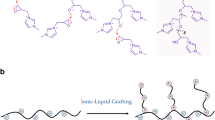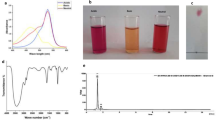Abstract
In this work, zoledronic acid-loaded cationic methylcellulose polyplex nanoparticles were developed for enhanced gene delivery efficiency and breast cancer cell killing effect. Zoledronic acid (Zol) is one of bisphosphonate derivatives, which is used for osteoporosis treatment and also can induce apoptosis to breast cancer cells. First, cationic methylcellulose (MCPEI) was synthesized by reductive amination of polyethylenimine (PEI, 0.8 kDa) with periodate-oxidized methylcellulose (MC). Negatively charged Zol was introduced to MCPEI polyplexes via surface coating of polyplex (Zol(MCPEI/pDNA)) or loading into polyplexes (MCPEI/(pDNA + Zol)). The complexes with suitable size for efficient transfection could be formed via loading method. MCPEI/(pDNA + Zol) complexes showed higher stability and endosome buffering capacity than MCPEI polyplexes, probably due to imidazole group of Zol. Although the transfection efficiency of Zol(MCPEI/pDNA) complexes was similar with or less than that of MCPEI polyplexes, MCPEI/(pDNA + Zol) complexes showed much higher transfection efficiency than MCPEI polyplexes in HeLa cells. In the bafilomycin A1-treated transfection results, the transfection efficiency of MCPEI/(pDNA + Zol) complexes was significantly decreased. These results mean that the transfection of MCPEI/(pDNA + Zol) complexes would be mediated by endocytosis and loaded Zol could improve the transfection efficiency of MCPEI polyplexes via endosome buffering. In addition, breast cancer cell killing effect of MCPEI/(pDNA + Zol) was examined using pJDK-apoptin in MDA-MB-231 cells. MCPEI/(pJDK-apoptin + Zol) complexes showed the highest cancer cell killing effect due to the combinatorial effect of Zol and apoptin. It is concluded that zoledronic acid-loaded polyplexes could improve the transfection efficiency and MCPEI/(pDNA + Zol) complexes showed the potential for anticancer therapy.









Similar content being viewed by others
References
Ahlfeld T, Guduric V, Duin S, Akkineni AR, Schütz K, Kilian D, Emmermacher J, Cubo-Mateo N, Dani S, Mv W, Spangenberg J, Abdelgaber R, Richter RF, Lode A, Gelinsky M (2020) Methylcellulose—a versatile printing material that enables biofabrication of tissue equivalents with high shape fidelity. Biomater Sci 8:2102–2110. https://doi.org/10.1039/d0bm00027b
Arboleya J-C, Wilde PJ (2005) Competitive adsorption of proteins with methylcellulose and hydroxypropyl methylcellulose. Food Hydrocolloids 19:485–491. https://doi.org/10.1016/j.foodhyd.2004.10.013
Au KM, Satterlee A, Min Y, Tian X, Kim YS, Caster JM, Zhang L, Zhang T, Huang L, Wang AZ (2016) Folate-targeted pH-responsive calcium zoledronate nanoscale metal-organic frameworks: turning a bone antiresorptive agent into an anticancer therapeutic. Biomaterials 82:178–193. https://doi.org/10.1016/j.biomaterials.2015.12.018
Bonetti L, Nardo LD, Fa Fare S (2020) Thermo-responsive methylcellulose hydrogels: from design to applications as smart biomaterials. Tissue Eng Part B-Rev. https://doi.org/10.1089/ten.teb.2020.0202
Bowman EJ, Siebers A, Altendorf K (1988) Bafilomycins: a class of inhibitors of membrane ATPases from microorganisms, animal cells, and plant cells. Proc Natl Acad Sci USA 85:7972–7976. https://doi.org/10.1073/pnas.85.21.7972
Caraglia M, Marra M, Naviglio S, Botti G, Addeo R, Abbruzzese A (2010) Zoledronic acid: an unending tale for an antiresorptive agent. Expert Opin Pharmacother 11:141–154. https://doi.org/10.1517/14656560903485664
Crider BP, Xie X-S, Stone DK (1994) Bafilomycin inhibits proton flow through the H+ channel of vacuolar proton pump. J Biol Chem 269:17379–17381
Giger EV, Puigmartí-Luis J, Schlatter R, Castagner B, Dittrich PS, Lerou J-C (2011) Gene delivery with bisphosphonate-stabilized calcium phosphate nanoparticles. J Control Release 150:87–93. https://doi.org/10.1016/j.jconrel.2010.11.012
Gillespie EJ, Ho C-LC, Balaji K, Clemens DL, Deng G, Wang YE, Elsaesser HJ, Tamilselvam B, Gargi A, Dixon SD, France B, Chamberlain BT, Blanke SR, Cheng G, de la Torre JC, Brooks DG, Jung ME, Colicelli J, Damoiseaux R, Bradley KA (2013) Selective inhibitor of endosomal trafficking pathways exploited by multiple toxins and viruses. Proc Natl Acad Sci USA 110:E4904–E4912. https://doi.org/10.1073/pnas.1302334110
Hirrien M, Desbrières J, Rinaudo M (1996) Physical properties of methylcelluloses in relation with the conditions for cellulose modification. Carbohydr Polym 31:243–252. https://doi.org/10.1016/S0144-8617(96)00118-X
Huh MS, Lee EJ, Koo H, Yhee JY, Oh KS, Son S, Lee S, Kim SH, Kwon IC, Kim K (2017) Polysaccharide-based nanoparticles for gene delivery. Top Curr Chem 375:31. https://doi.org/10.1007/s41061-017-0114-y
Jagdev SP, Coleman RE, Shipman CM, Rostami-H A, Croucher PI (2001) The bisphosphonate, zoledronic acid, induces apoptosis of breast cancer cells: evidence for synergy with paclitaxel. Br J Cancer 84:1126–1134. https://doi.org/10.1054/bjoc.2001.1727
Jeon JH, Park JH, Kim T-i (2019) Phenylboronic acid-conjugated cationic methylcellulose for hepatocellular carcinoma-targeted drug/gene co-delivery systems. J Ind Eng Chem 75:148–157. https://doi.org/10.1016/j.jiec.2019.03.016
Jeong JH, Kim SW, Park TG (2007) Molecular design of functional polymers for gene therapy. Prog Polym Sci 32:1239–1274. https://doi.org/10.1016/j.progpolymsci.2007.05.019
Kang HC, Huh KM, Bae YH (2012) Polymeric nucleic acid carriers: Current issues and novel design approaches. J Control Release 164:256–264. https://doi.org/10.1016/j.jconrel.2012.06.036
Khan W, Hosseinkhani H, Ickowicz D, Hong P-D, Yu D-S, Domb AJ (2012) Polysaccharide gene transfection agents. Acta Biomater 8:4224–4232. https://doi.org/10.1016/j.actbio.2012.09.022
Kim T-i, Rothmund T, Kissel T, Kim SW (2011) Bioreducible polymers with cell penetrating and endosome buffering functionality for gene delivery systems. J Control Release 152:110–119. https://doi.org/10.1016/j.jconrel.2011.02.013
Kim K, Ryu K, Kim T-i (2014) Cationic methylcellulose derivative with serum-compatibility and endosome buffering ability for gene delivery systems. Carbohydr Polym 110:268–277. https://doi.org/10.1016/j.carbpol.2014.03.073
Kim T, Park JH, Kim T-i (2019) Cholic acid-conjugated methylcellulose-polyethylenimine nano-aggregates for drug delivery systems. Nanomaterials 9:459. https://doi.org/10.3390/nano9030459
Kurosaki T, Kitahara T, Fumoto S, Nishida K, Nakamura J, Niidome T, Kodama Y, Nakagawa H, To H, Sasaki H (2009) Ternary complexes of pDNA, polyethylenimine, and gamma-polyglutamic acid for gene delivery systems. Biomaterials 30:2846–2853. https://doi.org/10.1016/j.biomaterials.2009.01.055
Leung BM, Lesher-Perez SC, Matsuoka T, Moraes C, Takayama S (2015) Media additives to promote spheroid circularity and compactness in hanging drop platform. Biomater Sci 3:336–344. https://doi.org/10.1039/c4bm00319e
Li EC, Davis LE (2003) Zoledronic acid: A new parenteral bisphosphonate. Clin Ther 25:2669–2708. https://doi.org/10.1016/S0149-2918(03)80327-2
Liang H-F, Hong M-H, Ho R-M, Chung C-K, Lin Y-H, Chen C-H, Sung H-W (2004) Novel method using a temperature-sensitive polymer (methylcellulose) to thermally gel aqueous alginate as a pH-sensitive hydrogel. Biomacromol 5:1917–1925. https://doi.org/10.1021/bm049813w
Liu W, Zhang B, Lu WW, Li X, Zhu D, Yao KD. Wang Q, Zhao C, Wang C (2004) A rapid temperature-responsive sol-gel reversible poly(N-isopropylacrylamide)-g-methylcellulose copolymer hydrogel. Biomaterials 25:3005-3012. https://doi.org/10.1016/j.biomaterials.2003.09.077
Lorkowski SW, Brubaker G, Gulshan K, Smith JD (2018) Vacuolar ATPase activity required for ABCA1 mediated cholesterol efflux. Arterioscler Thromb Vasc Biol 38:2615–2625. https://doi.org/10.1161/ATVBAHA.118.311814
Los M, Panigrahi S, Rashedi I, Mandal S, Stetefeld J, Essmann F, Schulze-Osthoff K (2009) Apoptin, a tumor-selective killer. Biochim Biophys Acta Mol Cell Res 1793:1335–1342. https://doi.org/10.1016/j.bbamcr.2009.04.002
Luo D, Saltzman WM (2000) Synthetic DNA delivery systems. Nat Biotechnol 18:33–37. https://doi.org/10.1038/71889
Ma PL, Lavertu M, Winnik FM, Buschmann MD (2017) Stability and binding affinity of DNA/chitosan complexes by polyanion competition. Carbohydr Polym 176:167–176. https://doi.org/10.1016/j.carbpol.2017.08.002
Maritan SM, Lian EY, Mulligan LM (2017) An efficient and flexible cell aggregation method for 3D spheroid production. J vis Exp 121:55544. https://doi.org/10.3791/55544
Marra M, Salzano G, Leonetti C, Tassone P, Scarsella M, Zappavigna S, Calimeri T, Franco R, Liguori G, Cigliana G, Ascani R, La Rotonda MI, Abbruzzese A, Tagliaferri P, Caraglia M, De Rosa G (2011) Nanotechnologies to use bisphosphonates as potent anticancer agents: the effects of zoledronic acid encapsulated into liposomes. Nanomedicine 7:955–964. https://doi.org/10.1016/j.nano.2011.03.004
Nasatto PL, Pignon F, Silveira JLM, Duarte MER, Noseda MD, Rinaudo M (2015) Methylcellulose, a cellulose derivative with original physical properties and extended applications. Polymers 7:777–803. https://doi.org/10.3390/polym7050777
Ottewell PD, Mönkkönen H, Jones M, Lefley DV, Coleman RE, Holen I (2008) Antitumor effects of doxorubicin followed by zoledronic acid in a mouse model of breast cancer. J Natl Cancer Inst 100:1167–1178. https://doi.org/10.1093/jnci/djn240
Park J, Kim K, Jeong S, Lee M, Kim T-i (2021) Highly osmotic oxidized sucrose-crosslinked polyethylenimine for gene delivery systems. Pharmaceutics 13:87. https://doi.org/10.3390/pharmaceutics13010087
Rachner TD, Singh SK, Schoppet M, Benad P, Bornhäuser M, Ellenrieder V, Ebert R, Jakob F, Hofbauer LC (2010) Zoledronic acid induces apoptosis and changes the TRAIL/OPG ratio in breast cancer cells. Cancer Lett 287:109–116. https://doi.org/10.1016/j.canlet.2009.06.003
Ryu K, Lee MK, Park J, Kim T-i (2018) pH-responsive charge-conversional poly(ethylene imine) −poly(L-lysine)−poly(L-glutamic acid) with self-assembly and endosome buffering ability for gene delivery systems. ACS Appl Bio Mater 1:1496–1504. https://doi.org/10.1021/acsabm.8b00428
Salzano G, Marra M, Porru M, Zappavigna S, Abbruzzese A, La Rotonda MI, Leonetti C, Caraglia M, De Rosa G (2011) Self-assembly nanoparticles for the delivery of bisphosphonates into tumors. Int J Pharm 403:292–297. https://doi.org/10.1016/j.ijpharm.2010.10.046
Verdijk R, Franke HR, Wolbers F, Vermes I (2007) Differential effects of bisphosphonates on breast cancer cell lines. Cancer Lett 246:308–312. https://doi.org/10.1016/j.canlet.2006.03.011
Wang Y, Lapitsky Y, Kang CE, Shoichet MS (2009) Accelerated release of a sparingly soluble drug from an injectable hyaluronan-methylcellulose gel. J Control Release 140:218–223. https://doi.org/10.1016/j.jconrel.2009.05.025
Wang I-T, Chou S-C, Lin Y-C (2014) Zoledronic acid induces apoptosis and autophagy in cervical cancer cells. Tumour Biol 35:11913–11920. https://doi.org/10.1007/s13277-014-2460-5
Xiao M-C, Chou Y-H, Hung Y-N, Hu S-H, Chiang W-H (2020) Hybrid polymeric nanoparticles with high zoledronic acid payload and proton sponge-triggered rapid drug release for anticancer applications. Mater Sci Eng C 116:111277. http://lps3.doi.org.libproxy.snu.ac.kr/https://doi.org/10.1016/j.msec.2020.111277
Zang X, Zhang X, Hu H, Qiao M, Zhao X, Deng Y, Chen D (2019) Targeted delivery of zoledronate to tumor-associated macrophages for cancer immunotherapy 16:2249. https://doi.org/10.1021/acs.molpharmaceut.9b00261
Zhang P, Wagner E (2017) History of polymeric gene delivery systems. Top Curr Chem (z) 375:26. https://doi.org/10.1007/s41061-017-0112-0
Zhou D, Li C, Hu Y, Zhou H, Chen J, Zhang Z, Guo T (2012) PLL/pDNA/P(His-co-DMAEL) ternary complexes: assembly, stability and gene delivery. J Mater Chem 22:10743–10751. https://doi.org/10.1039/C2JM30850A
Acknowledgements
This work was supported by the National Research Foundation of Korea (NRF), funded by the Ministry of Education (NRF-2017R1D1A1B03030556) and the Korean government (Ministry of Science and ICT) (NRF-2020R1A2C1011669).
Author information
Authors and Affiliations
Corresponding author
Ethics declarations
Conflicts of interest
On behalf of all authors, the corresponding author states that there is no conflict of interest.
Additional information
Publisher's Note
Springer Nature remains neutral with regard to jurisdictional claims in published maps and institutional affiliations.
Supplementary Information
Below is the link to the electronic supplementary material.
Rights and permissions
About this article
Cite this article
Seo, J., Jeong, S., Lee, M. et al. Zoledronic acid-loaded cationic methylcellulose polyplex nanoparticles for enhanced gene delivery efficiency and breast cancer cell killing effect. Appl Nanosci 12, 3303–3314 (2022). https://doi.org/10.1007/s13204-021-02127-5
Received:
Accepted:
Published:
Issue Date:
DOI: https://doi.org/10.1007/s13204-021-02127-5




